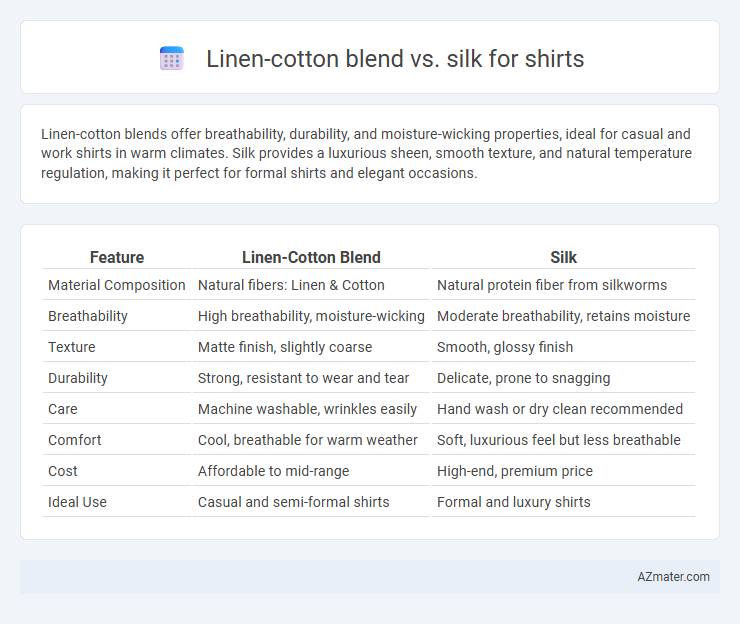Linen-cotton blends offer breathability, durability, and moisture-wicking properties, ideal for casual and work shirts in warm climates. Silk provides a luxurious sheen, smooth texture, and natural temperature regulation, making it perfect for formal shirts and elegant occasions.
Table of Comparison
| Feature | Linen-Cotton Blend | Silk |
|---|---|---|
| Material Composition | Natural fibers: Linen & Cotton | Natural protein fiber from silkworms |
| Breathability | High breathability, moisture-wicking | Moderate breathability, retains moisture |
| Texture | Matte finish, slightly coarse | Smooth, glossy finish |
| Durability | Strong, resistant to wear and tear | Delicate, prone to snagging |
| Care | Machine washable, wrinkles easily | Hand wash or dry clean recommended |
| Comfort | Cool, breathable for warm weather | Soft, luxurious feel but less breathable |
| Cost | Affordable to mid-range | High-end, premium price |
| Ideal Use | Casual and semi-formal shirts | Formal and luxury shirts |
Introduction to Linen-Cotton Blend and Silk Shirts
Linen-cotton blend shirts combine the breathability and moisture-wicking properties of linen with the softness and durability of cotton, offering a lightweight and comfortable option ideal for warm weather. Silk shirts feature a natural protein fiber with a smooth texture and subtle sheen, providing luxurious comfort and excellent temperature regulation suitable for both casual and formal occasions. Choosing between linen-cotton blend and silk depends on desired comfort, appearance, and care preferences, with silk requiring more delicate handling compared to the easy-care nature of linen-cotton blends.
Fabric Composition and Characteristics
Linen-cotton blend fabric typically consists of about 55-70% cotton and 30-45% linen, combining cotton's softness and durability with linen's breathability and natural texture, making it ideal for lightweight, moisture-wicking shirts. Silk, composed primarily of fibroin protein fibers produced by silkworms, offers a smooth, lustrous finish with excellent drape and hypoallergenic properties, but is less breathable compared to linen-cotton blends. The linen-cotton blend excels in moisture absorption and airflow, suitable for hot climates, whereas silk provides a luxurious feel and sheen, often preferred for formal or delicate shirt designs.
Comfort and Breathability Comparison
Linen-cotton blend shirts provide superior breathability and moisture-wicking capabilities, making them ideal for hot and humid climates due to the natural fibers' ability to allow air circulation and absorb sweat. Silk shirts, while smooth and lightweight, tend to retain heat and offer less ventilation compared to linen-cotton blends, which can result in reduced comfort during extended wear in warm conditions. The durability and softness of the linen-cotton blend further enhance comfort by preventing excessive clinginess and promoting a cool, dry feel throughout the day.
Durability and Longevity
Linen-cotton blends offer superior durability and longevity compared to silk, as the combination of natural fibers provides resistance to wear, tear, and frequent washing. These blends maintain structural integrity and resist pilling better than delicate silk, making them ideal for everyday shirts. Silk, while luxurious and smooth, is more prone to abrasion and requires careful handling to preserve its lifespan.
Style and Aesthetic Appeal
Linen-cotton blend shirts offer a relaxed, breathable texture with a matte finish that enhances casual and rustic styles, ideal for warm weather and effortless elegance. Silk shirts provide a smooth, lustrous surface with a natural sheen, exuding luxury and sophistication suitable for formal or evening wear. The choice between linen-cotton blend and silk depends on the desired aesthetic, balancing comfort and understated charm against opulence and polished refinement.
Care and Maintenance Requirements
Linen-cotton blend shirts require regular washing with mild detergents to maintain fabric softness and prevent shrinkage, and they should be air-dried to avoid damage from high heat. Silk shirts need gentle hand washing or dry cleaning to preserve their delicate fibers, and they must be kept away from prolonged exposure to sunlight and excessive moisture to prevent weakening and color fading. Proper storage in cool, dry places and using padded hangers help maintain the shape and longevity of both fabrics.
Suitability for Different Climates
Linen-cotton blend shirts excel in hot and humid climates due to their breathability and moisture-wicking properties, providing lightweight comfort and durability. Silk shirts are better suited for mild to cooler temperatures, offering natural insulation and a smooth texture while maintaining moderate breathability. For versatile climate wear, linen-cotton blends provide superior airflow and quick drying, whereas silk adds luxury with temperature regulation in less extreme conditions.
Sustainability and Environmental Impact
Linen-cotton blend shirts offer a more sustainable and environmentally friendly option due to their natural fibers, lower water consumption, and biodegradable properties compared to silk. Linen production requires less pesticide use and has a smaller carbon footprint, while cotton's impact can be mitigated through organic farming methods. Silk manufacturing involves energy-intensive processes and the cultivation of mulberry trees, which can lead to habitat disruption and higher water usage, making linen-cotton blends a preferable choice for eco-conscious consumers.
Price and Value Analysis
Linen-cotton blend shirts typically offer a more affordable price point, combining the breathability and durability of linen with the softness of cotton, making them a cost-effective choice for everyday wear. Silk shirts, while more expensive due to the luxurious texture and natural sheen, provide superior comfort and elegance but may require more delicate care and maintenance. Evaluating value depends on balancing budget constraints with desired fabric performance, where linen-cotton blends excel in practicality and silk stands out in premium appeal.
Which Fabric is Best for Your Shirt?
Linen-cotton blend offers breathability, durability, and easy maintenance, making it ideal for casual and everyday shirts that require comfort and wrinkle resistance. Silk provides a luxurious feel with natural sheen and softness, perfect for formal or special occasion shirts that prioritize elegance and a smooth finish. Choosing the best fabric depends on your shirt's purpose, with linen-cotton blend excelling in versatility and durability, while silk delivers premium comfort and style.

Infographic: Linen-cotton blend vs Silk for Shirt
 azmater.com
azmater.com